
The Clinical Problem
Over 4 million patients seek medical treatment each year because of a rotator cuff injury. Many of these patients will require surgery for treatment of their rotator cuff injury. Unfortunately, the failure rate for rotator cuff surgery has been reported to be between 20% and over 90% in many instances. The most common reason for lack of success of such rotator cuff surgeries is structural failure at the surgical site.
|
X-Repair
X-Repair is a specialized surgical mesh with mechanical properties equivalent to human tendon, allowing it to support function of surgically repaired tendon and other soft tissues.
It is specifically designed to reinforce surgical repair of tendon and other soft tissues, including reinforcement of rotator cuff, patellar, Achilles, biceps and quadriceps tendons.
After the repair process is complete, the material dissolves at the surgical site.
|
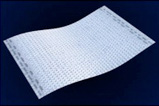
X-Repair surgical mesh
|
|
Rotator Cuff
The rotator cuff is a set of tendons attaching muscles to the upper arm. The tendons provide stability and strength to the shoulder.
|
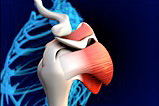
Rotator cuff tendons of the shoulder
|
|
Rotator Cuff Tears
The tendons (one or more) may tear, or tear away from the bone, and need to be repaired surgically. When the surgery is at risk of failure (re-tear) then X-Repair may be used to strengthen the surgical repair and increase the chance of successful long term repair.
|
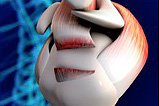
Rotator cuff tendon tear
|
|
Surgical Treatment
Your orthopedic surgeon may recommend surgery if:
- Nonsurgical treatment does not relieve symptoms
- The tear has just occurred and is very painful
- The tear is in the shoulder of the dominant arm of an active person
- If maximum strength in the arm is needed for overhead work or sports
The type of surgery performed depends on the size, shape, and location of the tear. A partial tear may require only a trimming or smoothing procedure, called a " debridement. " A complete tear is repaired by suturing the tendon back together. If the tendon is torn away from where it inserts into the bone of the arm (humerus), it is repaired directly to bone.
|
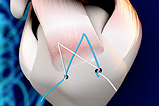
Rotator cuff tendon surgical repair
|
|
Risk of Failure of Rotator Cuff Repair
A review of published studies show the success of rotator cuff surgical repair is not guaranteed. As shown in the table below, when the surgical outcome is assessed by MRI or ultrasound, the success rate of rotator cuff surgery on large and massive tears is low.
|
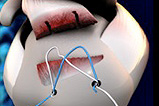
Rotator cuff tendon re-tear
after surgery
|
| Rotator Cuff Tear |
Success Rate |
| Massive (2 or more tendons, >5 cm) |
40% |
| Large (3 – 5 cm) |
52% |
| Small to Medium (1 – 3 cm) |
74% |
|
|
Augmentation of Surgical Repair with X-Repair
X-Repair might be appropriate whenever there is a risk of a re-tear of the surgical repair. This may be when:
- The tear is massive (greater than 5 cm)
- The tear is large (3 – 5 cm)
- The tear is a repair of a previously surgically repaired rotator cuff
- The tear is chronic
- The tear is small to medium (1 – 3 cm) but still at risk for re-tear due to other factors
|
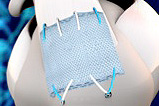
Rotator cuff tendon surgical repair
using X-Repair
|
|
What to do
If you are considering having rotator cuff surgery and you feel the use of X-Repair may be of value, contact your surgeon and discuss the use of X-Repair.
|
Useful Links
American Academy of Orthopaedic Surgeons:
http://www.aaos.org/
http://orthoinfo.aaos.org/topic.cfm?topic=A00064
National Institutes of Health, National Institute of Arthritis and Musculoskeletal and Skin Diseases (NIAMS):
http://www.niams.nih.gov/
http://www.niams.nih.gov/Health_Info/Shoulder_Problems/default.asp
Wikipedia
http://en.wikipedia.org/wiki/Rotator_cuff

 FAQs
FAQs






